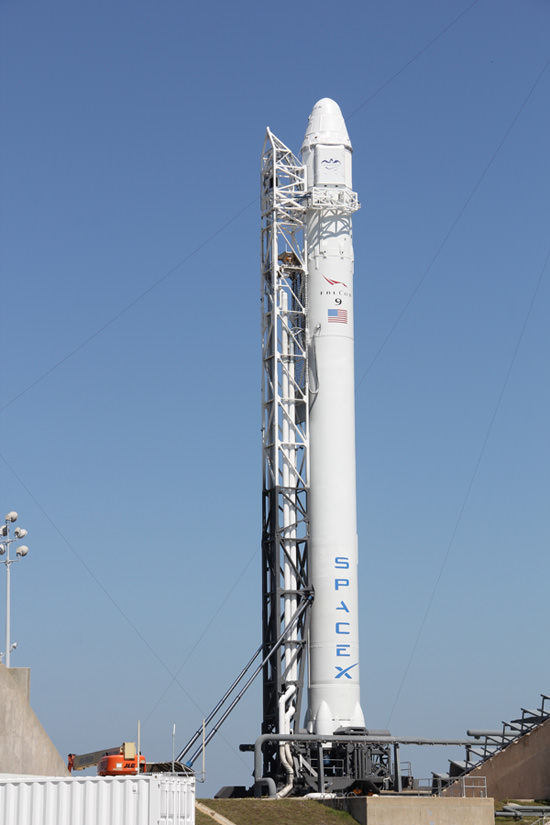Kennedy Space Center – All systems are GO and the weather outlook looks spectacular for the March 1 blast off of the privately developed SpaceX Falcon 9 rocket to the International Space Station (ISS).
The Falcon 9 is slated to lift off at 10:10 AM EST with a Dragon capsule loaded with fresh supplies and science gear to continued full up operation and utilization of the ISS.
Right now the weather forecast is at 80% GO on March 1 – with superbly beautiful, clear blue skies here in sunny and comfortably warm Florida from Space Launch Complex 40 at Cape Canaveral Air Force Station.
Large crowds of eager tourists, sightseers and space enthusiasts are already gathering in local hotels – most are sold out including at my hotel where I have been holding well attended ISS star parties during excellent evening viewing opportunities this week.
NASA TV will provide live launch coverage starting at 8 30 AM. SpaceX will also provide a separate feed starting about 40 minutes prior to launch.
The two stage Falcon 9 rocket was rolled out horizontally to the pad late this afternoon (Thursday, Feb. 28) in anticipation of a Friday morning launch. Myself and Dave Dickinson are on-site for Universe Today
The mission dubbed CRS-2 will be only the 2nd commercial resupply mission ever to the ISS.
There are no technical concerns at this time. Saturday March 2 is the back-up launch date in case of a last second scrub. Weather is projected as 80% favorable.
SpaceX President Gwynne Shotwell and NASA officials told me that additional launch opportunities are available Sunday, Monday and Tuesday, if needed, and later until about March 11. After that, the launch team would have to stand down to make way for the next eventual departure of a docked Soyuz and launch of a manned Russian Soyuz capsule with a new three man crew.

The SpaceX Dragon capsule is carrying about 1,200 pounds of vital supplies and research experiments for the six man international crew living aboard the million pound orbiting outpost.
SpaceX is under contract to NASA to deliver over 44,000 pounds of cargo to the ISS during a dozen flights over the next few years at a cost of about $1.6 Billion.
The capsule is fully loaded Shotwell told me. An upgraded Falcon 9 will be used in the next launch that will allow for a significant increase in the cargo up mass, Shotwell elaborated.
The Dragon is due to dock with the ISS in record time some 20 hours after blast off.


Did he happen to mention as to whether they’re purposefully choosing to launch high volume, low mass items while using the Block 1 Falcon 9 in order to get the most out of the very low cargo masses? Or are they just leaving the Dragon half empty volume wise?
Either way an empty Dragon is at the payload limit of a Block 1 when launching to the ISS.
Block 1 payload to ISS: ~ 7500kg.
Falcon 9 V1.1 payload to ISS ~12000kg.
Dry mass of empty Dragon: 4200kg.
That leaves only 3300kg for fuel and cargo for the Block 1 Falcon, but 7800kg for fuel and cargo for the V1.1 Falcon. So the V1.1 should be able to launch a nearly fully loaded Dragon (5 tonnes or so, while max designed load is 6 tonnes) to the ISS.
Am curious… will the CRS-2 flight include a ‘piggy back’ ORBCOMM or other *.sat like CRS-1?
Good question. I was thinking on the same lines.
I’m wondering why commercial logos aren’t being displayed on SpaceX rockets to offset costs. (“Just do it!”)
Are they (commercial) reluctant in case there’s a failure in this company’s young history and they think it might somehow reflect on their products?
I’ve done a quick search for the info, without success.